Magnetism and electricity: Identify, describe and apply properties of electricity in an electric circuit
Unit 4: Safety with electricity
Leigh Kleynhans
Unit 4 outcomes
By the end of this unit you will be able to:
- Describe the reason for electrical safety and earthing.
What you should know
Before you start this unit, make sure you can:
- Apply the basic principles of electrical circuits.
- Apply the concepts of electric current, as covered in Subject outcome 4.3, Unit 1.
Introduction
Most of us use electricity every day in many different ways so it is important that we understand the dangers, or hazards, associated with electricity and we know how to use it safely.
Electrical hazards
A hazard occurs when there is electrical overheating. The current becomes too high and the temperature of the wires increases. If the wires are in contact with a material, the material will catch fire.
Electric energy is converted to thermal energy at a rate faster than it can be safely dissipated. This can happen in two ways: if circuits are overloaded (too many appliances are connected to the same source) or if there is a , a low-resistance path between the terminals of a voltage source. An example of a short circuit is shown in Figure 1. Insulation on wires leading to an appliance wears through, allowing the two wires to come into contact with one another. Since the resistance of the circuit is now very small, the power dissipated is very large, much greater than that used by a typical household appliance. Thermal energy delivered at this rate will very quickly raise the temperature of surrounding materials, melting, or perhaps igniting them.
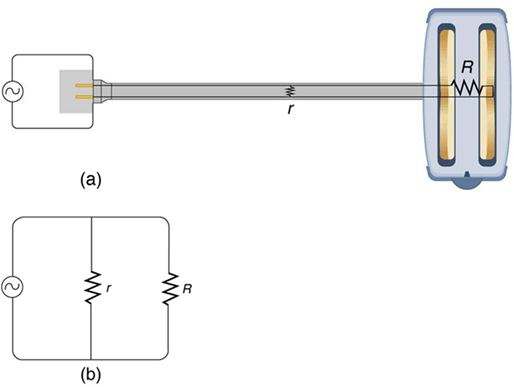
A hazard occurs when high electric current passes through a person. Electrical currents through people produce tremendously varied effects. An electrical current can be used to block back pain, stimulate muscle action in paralysed limbs and electrical shocks are used to bring a heart attack victim out of ventricular fibrillation (a massively irregular, often fatal, beating of the heart). A pacemaker is a device that is implanted in a human body and uses electrical shocks to stimulate the heart to beat properly. However, electric shocks can also be fatal. The major factors that determine the effects of an electrical shock depend on the amount of current and the duration.
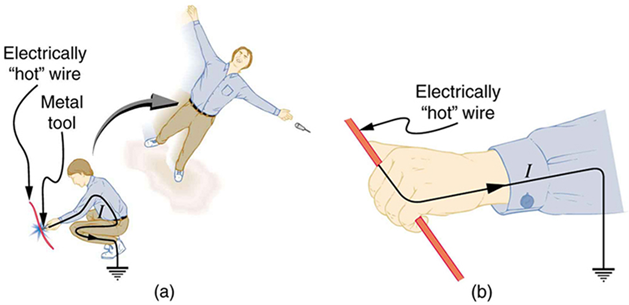
Very high currents will cause a fatal shock, referred to as . There are lots of ways in which we can be electrocuted including:
- touching frayed electrical cables
- touching damaged or incorrectly wired plugs
- allowing water or wet objects to enter plug sockets or touching frayed cables
- pushing metal objects into plug sockets.
Safety features
Modern appliances have features to prevent both thermal and shock hazards.
Fuses
A breaks the circuit if a fault in an appliance causes too much current to flow. This protects both the wiring and the appliance and prevents the overheating of wires. The fuse contains a piece of wire that melts easily. If the current going through the fuse is too great, the wire heats up until it melts and breaks the circuit, preventing further overheating which could cause a fire.
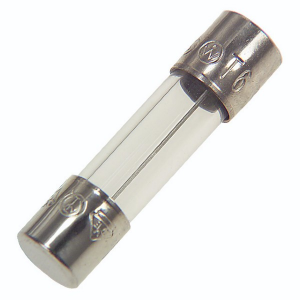
A fuse should be rated at a slightly higher current than the device needs, so:
- if the device works at 3 A, use a 5 A fuse
- if the device works at 10 A, use a 13 A fuse.
This will ensure that, if the current starts to increase beyond the maximum capacity of the device it will melt and break the circuit before serious overheating arises.
Circuit breakers
act as resettable fuses. These are automatically operated electrical switches that protect electrical circuits from overloading or short circuiting. They detect faults and then stop the flow of electricity. Small circuit breakers protect individual household appliances, whereas larger ones can protect high voltage circuits supplying electricity to entire cities.
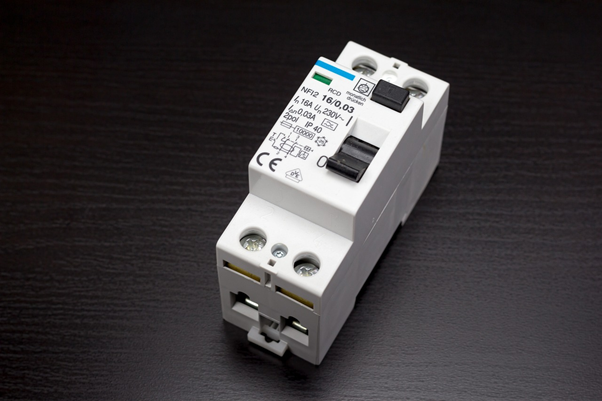
Earthing
is the connection of an electrical device or supply to the Earth for the purpose of creating a pathway for excess charge to return safely into the ground.
A mains electricity cable contains two or three inner wires. Each has a core of copper because copper is a good conductor of electricity. The outer layers are flexible plastic because plastic is a good electrical insulator. The inner wires are colour coded and have different functions:
- brown: this is the live wire that is connected to the voltage source
- blue: this is the neutral wire that completes the circuit
- green and yellow stripes: this is the earth wire that allows excess charge to travel to the Earth.
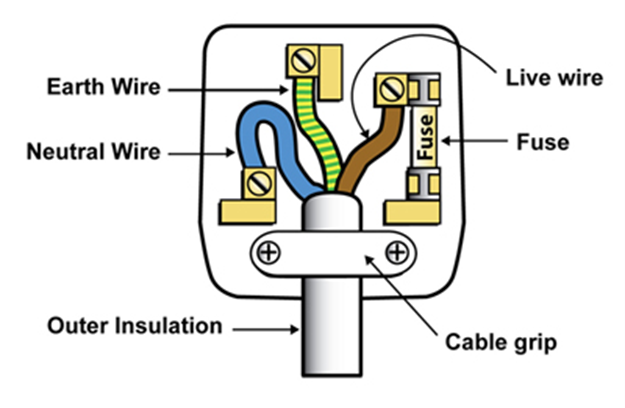
Many electrical appliances, including stoves, washing machines and refrigerators, have metal cases. You would get an electric shock if the live wire inside an appliance, such as a stove, came loose and touched the metal casing. However, the earth terminal is connected to the metal casing so that the current goes through the earth wire instead of causing an electric shock.
Double insulation
Some appliances, such as hairdryers and electric drills, do not have an earth wire. This is because they have plastic casings, or they have been designed so that the live wire cannot touch the casing. As a result, the casing cannot give an electric shock, even if the wires inside become loose. These appliances have .
Note
To consolidate the concepts covered in this unit, watch this video called Wires by Fuseschools (Duration: 3.59).
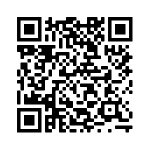
Summary
In this unit you have learnt the following:
- Electrical hazards can be divided into thermal hazards and shock hazards.
- Thermal hazards, like overloading and short circuits, can result in fires.
- Shock hazards can cause severe injury or even death.
- Electrical safety features include:
- fuses
- circuit breakers
- earthing
- double insulation.
Unit 4: Assessment
Suggested time to complete: 10 minutes
- Choose the letter of the most correct answer to the following questions:
- Which colour wire carries high voltage in an electric cable?
- Red
- Blue
- Green and yellow stripes
- Brown
- What colour is the neutral wire in an electric cable?
- Red
- Blue
- Green and yellow stripes
- Brown
- What colour is the earth wire in an electric cable?
- Red
- Blue
- Green and yellow stipes
- Brown
- What causes a fuse to blow in a circuit?
- Too little current
- Too little voltage
- Too much current
- Too much voltage
- The functioning of a fuse is based on the fact that:
- it is made of an insulator
- it has no resistance
- it does not allow current to flow through it
- it is made of a metal that melts easily
- How does an earthing wire function as a safety feature?
- It has a low resistance so charge can flow quickly to the Earth
- It has a high resistance so excess charges are prevented from flowing
- It connects to the casing of an appliance to disperse charge around the outside of the appliance
- It melts when there is excess charge in the appliance
- Which of these describes the relationship between the current in an electrical device and a fuse?
- The fuse rating and the current should be equal
- The current should be higher than the fuse rating
- The fuse rating should be much higher than the current
- The fuse rating should be slightly higher than the current
- Which colour wire carries high voltage in an electric cable?
- Explain why it is dangerous to use electrical appliances in a bathroom.
The full solutions are at the end of the unit.
Unit 4: Solutions
Unit 4: Assessment
- .
- D
- B
- C
- C (too much current increases the thermal energy in the wire and melts it)
- D (the circuit needs to be broken so melting creates a gap in the circuit)
- A (low resistance will mean charges can go quickly into the ground and reduce danger of a shock)
- D (the fuse must break the circuit when current is slightly higher than capacity of appliance so that overheating will not occur)
- Water conducts electricity because dissolved particles (ions) are charged particles. The water can therefore conduct electricity from any electrical appliance to the person who is holding it and they could be shocked.
Media Attributions
- img01_Figure1 © OpenStax is licensed under a CC BY (Attribution) license
- img02_Figure2 © OpenStax is licensed under a CC BY (Attribution) license
- img03_Figure3 © L Kleynhans is licensed under a CC BY (Attribution) license
- img04_Figure4 © Pixabay is licensed under a CC0 (Creative Commons Zero) license
- img05_Figure5 © L Kleynhans is licensed under a CC BY (Attribution) license
- QR_Code_PSL2SO43U4_1
having to do with heat
material that can burn
when two wires touch each other cutting off a resistor in a circuit creating a pathway with a much lower resistance resulting in high current and overheating
an electric current that travels through the body
death or severe injury caused by high electric current travelling through the body
a safety device consisting of a thin wire that melts easily breaking the circuit when the current gets too high
automatic safety switches that break a circuit when the current level gets too high
when appliances have a third earth wire connected to the Earth to allow excess charge to travel into the ground preventing electrical shocks
plastic casing around appliances so that even if the plastic covering of the wires gets damaged and the wires touch the casing, a person cannot get shocked
